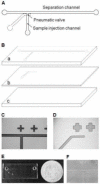Hydrodynamic injection with pneumatic valving for microchip electrophoresis with total analyte utilization
- PMID: 21520147
- PMCID: PMC3124583
- DOI: 10.1002/elps.201000522
Hydrodynamic injection with pneumatic valving for microchip electrophoresis with total analyte utilization
Abstract
A novel hydrodynamic injector that is directly controlled by a pneumatic valve has been developed for reproducible microchip CE separations. The PDMS devices used for the evaluation comprise a separation channel, a side channel for sample introduction, and a pneumatic valve aligned at the intersection of the channels. A low pressure (≤ 3 psi) applied to the sample reservoir is sufficient to drive sample into the separation channel. The rapidly actuated pneumatic valve enables injection of discrete sample plugs as small as ~ 100 pL for CE separation. The injection volume can be easily controlled by adjusting the intersection geometry, the solution back pressure, and the valve actuation time. Sample injection could be reliably operated at different frequencies (< 0.1 Hz to > 2 Hz) with good reproducibility (peak height relative standard deviation ≤ 3.6%) and no sampling biases associated with the conventional electrokinetic injections. The separation channel was dynamically coated with a cationic polymer, and FITC-labeled amino acids were employed to evaluate the CE separation. Highly efficient (≥ 7.0 × 10³ theoretical plates for the ~2.4-cm-long channel) and reproducible CE separations were obtained. The demonstrated method has numerous advantages compared with the conventional techniques, including repeatable and unbiased injections, little sample waste, high duty cycle, controllable injected sample volume, and fewer electrodes with no need for voltage switching. The prospects of implementing this injection method for coupling multidimensional separations for multiplexing CE separations and for sample-limited bioanalyses are discussed.
Copyright © 2011 WILEY-VCH Verlag GmbH & Co. KGaA, Weinheim.
Figures













Similar articles
-
Pneumatic microvalve-based hydrodynamic sample injection for high-throughput, quantitative zone electrophoresis in capillaries.Anal Chem. 2014 Jul 1;86(13):6723-9. doi: 10.1021/ac501910p. Epub 2014 Jun 9. Anal Chem. 2014. PMID: 24865952 Free PMC article.
-
Electrokinetic sample preconcentration and hydrodynamic sample injection for microchip electrophoresis using a pneumatic microvalve.Electrophoresis. 2016 Feb;37(3):455-62. doi: 10.1002/elps.201500286. Epub 2015 Nov 6. Electrophoresis. 2016. PMID: 26255610
-
Pressure-actuated microfluidic devices for electrophoretic separation of pre-term birth biomarkers.Anal Bioanal Chem. 2016 Jan;408(2):599-607. doi: 10.1007/s00216-015-9141-0. Epub 2015 Nov 4. Anal Bioanal Chem. 2016. PMID: 26537925 Free PMC article.
-
Microchip capillary electrophoresis: application to peptide analysis.Methods Mol Biol. 2006;339:159-86. doi: 10.1385/1-59745-076-6:159. Methods Mol Biol. 2006. PMID: 16790873 Review.
-
Interfacing amperometric detection with microchip capillary electrophoresis.Methods Mol Biol. 2006;339:85-112. doi: 10.1385/1-59745-076-6:85. Methods Mol Biol. 2006. PMID: 16790869 Review.
Cited by
-
Controlled dispensing and mixing of pico- to nanoliter volumes using on-demand droplet-based microfluidics.Microfluid Nanofluidics. 2013 Jul 1;15(1):117-126. doi: 10.1007/s10404-012-1133-1. Microfluid Nanofluidics. 2013. PMID: 23935562 Free PMC article.
-
Membrane-based emitter for coupling microfluidics with ultrasensitive nanoelectrospray ionization-mass spectrometry.Anal Chem. 2011 Jul 15;83(14):5797-803. doi: 10.1021/ac200960h. Epub 2011 Jun 22. Anal Chem. 2011. PMID: 21657269 Free PMC article.
-
Pneumatic microvalve-based hydrodynamic sample injection for high-throughput, quantitative zone electrophoresis in capillaries.Anal Chem. 2014 Jul 1;86(13):6723-9. doi: 10.1021/ac501910p. Epub 2014 Jun 9. Anal Chem. 2014. PMID: 24865952 Free PMC article.
-
Novel volumetric method for highly repeatable injection in microchip electrophoresis.Anal Chim Acta. 2017 Sep 8;985:129-140. doi: 10.1016/j.aca.2017.05.037. Epub 2017 Jun 19. Anal Chim Acta. 2017. PMID: 28864183 Free PMC article.
-
Toward miniaturized analysis of chemical identity and purity of radiopharmaceuticals via microchip electrophoresis.Anal Bioanal Chem. 2018 Mar;410(9):2423-2436. doi: 10.1007/s00216-018-0924-y. Epub 2018 Feb 22. Anal Bioanal Chem. 2018. PMID: 29470664 Free PMC article.
References
-
- Reyes DR, Iossifidis D, Aurous P-A, Manz A. Anal. Chem. 2002;74:2623–2636. - PubMed
-
- Aurous P-A, Iossifidis D, Reyes DR, Manz A. Anal. Chem. 2002;74:2637–2652. - PubMed
-
- Effenhauser CS, Manz A, Widmer HM. Anal. Chem. 1993;65:2637–2642.
-
- Harrison DJ, Fluri K, Seiler K, Fan Z, Effenhauser CS, Manz A. Science. 1993;261:895–897. - PubMed
Publication types
MeSH terms
Substances
Grants and funding
LinkOut - more resources
Full Text Sources
Other Literature Sources

